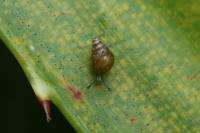July 12, 2011 report
Tiny snails survive in bird's digestive system

(PhysOrg.com) -- In a recent study published in the Journal of Biogeography, researchers from the Tohoku University in Japan show how 15 percent of the Tornatellides boeningi, or tiny land snail, are able to survive a bird’s digestive system and emerge alive in the bird’s droppings.
Researcher Shinichiro Wada and his team were observing the diet of the bird population of Japanese white-eyes and brown-eared bulbuls that inhabit the Hahajima Island. Their studies revealed that the bird’s had a preference for the tiny snails, but they were surprised by the amount of snails that were able to survive a trip through the bird’s digestive system.
The researchers then turned their studies to the T. boeningi and found genetic differences throughout the populations on the island. Their results revealed that snails were mating with populations found on other areas of the island. While scientists have seen this type of long distance dispersal pattern before, explanations of how different groups ended up with each other was always speculation and usually involved the theory of traveling on bird’s feet.
This is the first study of its kind to show that the bird’s and their droppings are able to disperse living snails to other geographical locations. One snail managed to show the researchers that entire snail families could be transported by the birds. Not long after being ingested, one small gave birth to juveniles not long after passing through the gut of the bird.
These tiny snails are an average 2.5mm and researchers believe it may be their size that helps them survive. Larger species of snails show severe damage to their shells when ingested by the birds while the T. boeningi remains intact.
The researchers plan to conduct further studies into the tiny snail and discover if their survival is a matter of pure luck or if they have managed to adapt in a way that allows them to survive their digestive track travels.
More information: Snails can survive passage through a bird’s digestive system, Journal of Biogeography, DOI:10.1111/j.1365-2699.2011.02559.x
Abstract
Aim Predation is generally viewed as a factor that limits the distribution of animal prey species. However, in certain instances, such as seed dispersal, predation may enhance the dispersal capability of prey species. In a prior study, we found that land snails are preyed upon by the Japanese white-eye (Zosterops japonicus) and the brown-eared bulbul (Hypsipetes amaurotis) in the Ogasawara Islands. In this paper we provide experimental and field evidence indicating that land snails could potentially be dispersed through bird predation.
Location Hahajima Island of the Ogasawara Islands in the western Pacific.
Methods Experimentation was first performed to test whether the land snail Tornatellides boeningi could remain alive after being swallowed and passed through the bird digestive system. Next, in order to investigate the potential role of internal bird transport and dispersal of this snail, we investigated the relationship between the distribution of population genetic diversity in the snail and the regional geographical abundance of predatory birds. The population genetic structure of T. boeningi and isolation by distance were inferred with Arlequin. The association between nucleotide diversity in T. boeningi populations and population density of predators was examined using a generalized linear mixed model. We conducted a likelihood ratio test for the full model and for another model that removed the fixed effect.
Results Of the 119 snails fed to Japanese white-eyes and 55 snails fed to brown-eared bulbuls, 14.3% and 16.4% of the snails, respectively, passed through the gut alive. Additionally, one snail gave birth to juveniles after emerging from a bird’s gut. Significant heterogeneity among the populations of T. boeningi on Hahajima was indicated using AMOVA; however, there was no evidence of isolation by distance. A positive correlation was found between levels of mitochondrial DNA variation among and within T. boeningi populations and the density of Japanese white-eyes in the wild.
Main conclusions Bird predation appears to be a method of dispersal for T. boeningi, and our results suggest that bird-mediated dispersal plays a role in land snail population structure.
© 2010 PhysOrg.com



















